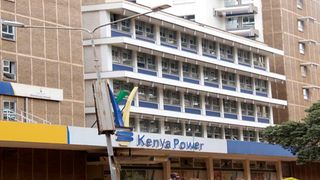
Kenya Power building along Aga Khan Walk, Nairobi in this picture taken on August 15, 2021.
| Lucy Wanjiru | Nation Media GroupBusiness
Premium
Kenya Power is broke, says Auditor General
What you need to know:
- Kenya Power’s liabilities of Sh116.11 billion exceed it assets of Sh49.63 billion by Sh66.47 billion.
- The Auditor General warned that Kenya Power is too reliant on its operating cash flows.
Utility firm Kenya Power is insolvent and requires urgent government bailout, Auditor General Nancy Gathungu has said.
A report of the company’s financials for the year to June, shows its current liabilities far exceed its assets, keeping it with a negative working capital for the fifth year straight.
Kenya Power’s liabilities of Sh116.11 billion exceed it assets of Sh49.63 billion by Sh66.47 billion.
However, the negative company’s working capital has improved from Sh74.84 billion last year on upward revision of its current assets and repayment of some of its mountain of debt during the period.
Ms Gathungu said some of the reform measures instituted by the company in financial year 2020/21 appear to have yielded little results in improving its financial position.
“The board of directors and management in the past and in the year under review indicated strategic initiatives that were being undertaken to improve the financial results as at June 30, 2021. As further stated, this condition, along with other matters as set forth, indicates existence of material uncertainty that may cast significant doubt on the company’s ability to continue as a going concern,” she said.
The Auditor General warned that Kenya Power is too reliant on its operating cash flows to finance its debt repayments and capital spending which could make it unable to meet its obligations should it fail to collect enough electricity revenues in any given period.
Technical insolvency
Ms Gathungu added that, while the utility firm is seeking to improve its financial performance, it would need additional funding for capital expenditure to expand, improve and maintain its network, which could further sink it into more debt.
Further, the Auditor General warned, Kenya Power’s continued technical insolvency will make it harder for the government or shareholders to provide it with cash injections or approvals for mobilization of loans from other sources.
But National Treasury Principal Secretary Julius Muia last month said the government has no plans to bailout the company.
Appearing before the National Assembly’s Energy Committee to explain Treasury’s role in granting letters of support for power purchase agreements to independent power producers blamed for high electricity prices, Mr Muia refuted claims that the company was in plans to inject billions into the company to make it stay afloat.
“We have no such plans (for a bailout),” Mr Muia said in response to queries by Gem Member of Parliament Elisha Odhiambo. “The monies we are currently planning to disburse to the company is what we owe them for the rural electrification programme, and this money has already been budgeted for this year,” he said.
The government owes Kenya Power over Sh11.9 billion for managing the rural electricity network through the Rural Electrification Scheme.
Kenya Power bounced back from a Sh939 million net loss last year to a Sh1.49 billion after tax profit for the year to June on higher electricity sales and lower operating costs. The power distributor posted an 8.4 per cent rise in revenue from electricity sales to Sh125.92 billion, while operating costs fell by Sh7.97 billion to Sh39.86 billion from Sh47.83 billion last year.





